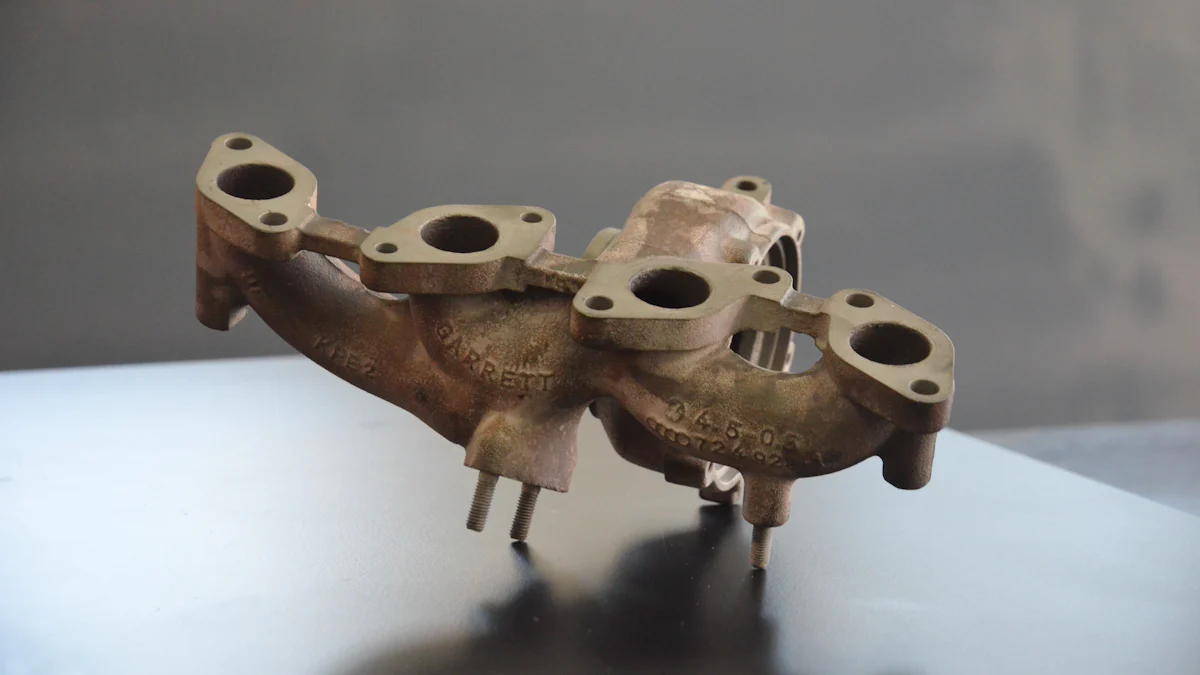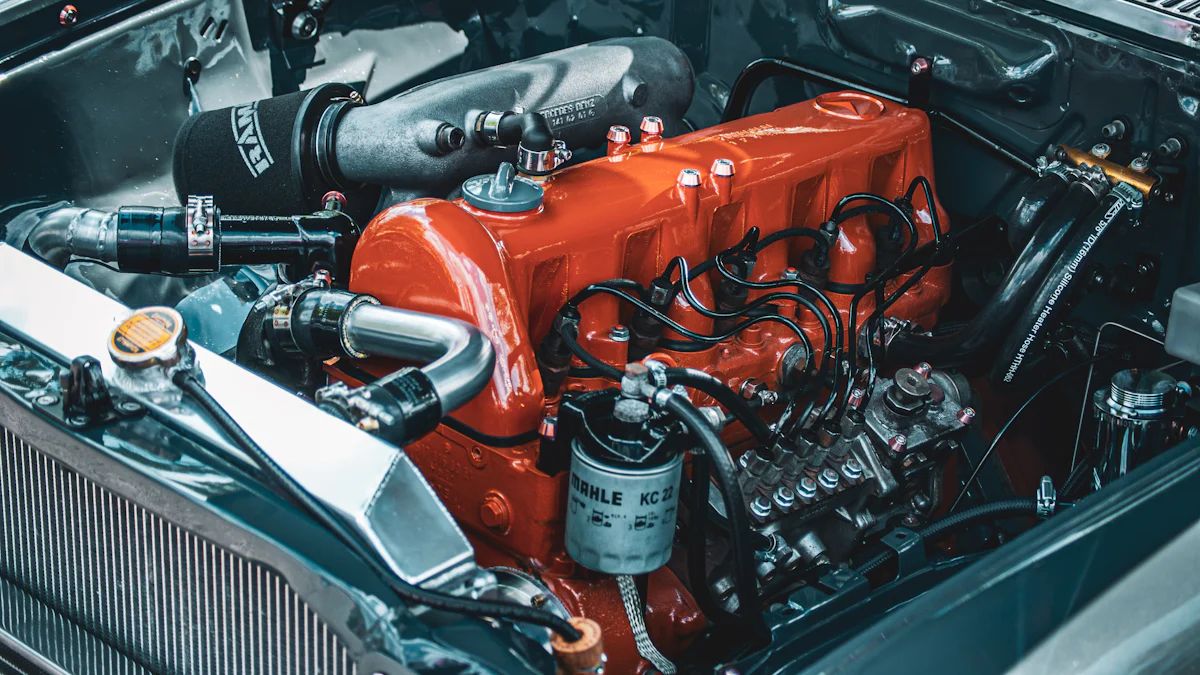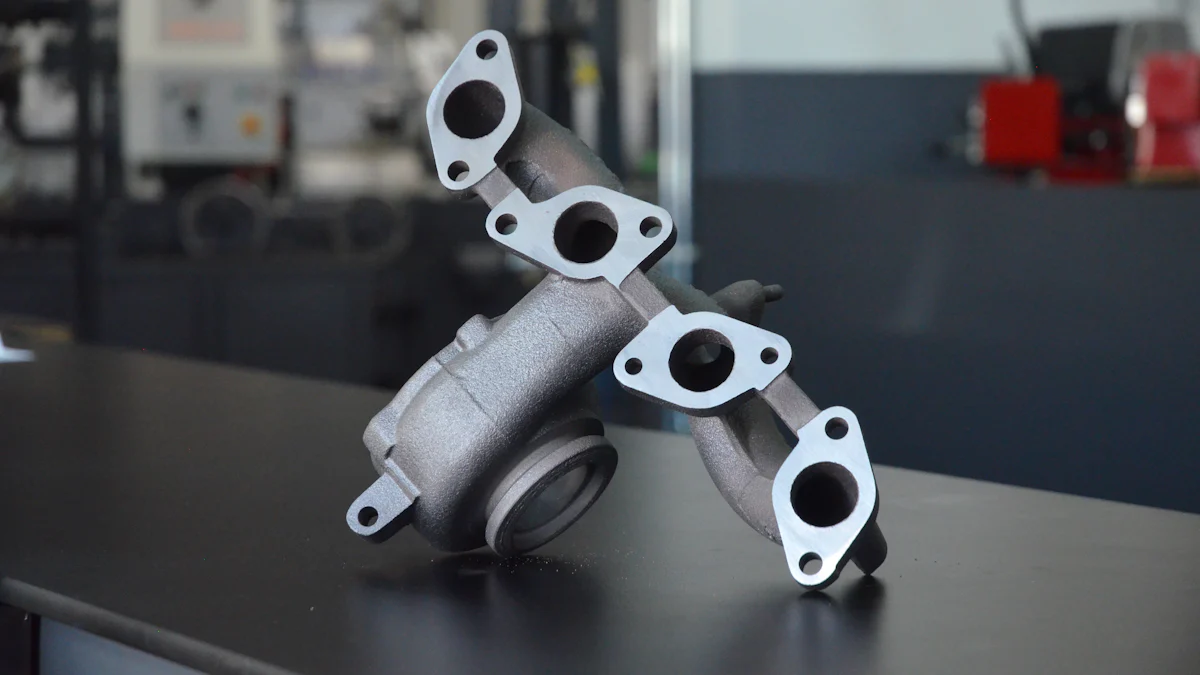
The Exhaust Manifold In Car Engine is essential for the vehicle’s performance, acting as a collector that gathers exhaust gases from the engine’s cylinders and directs them to the Exhaust Manifold Converter. This process ensures the engine operates smoothly and efficiently. Constructed from durable materials like Cast Iron Exhaust Manifold, it withstands high temperatures and pressure. In High Performance Transmission systems, the design of the exhaust manifold becomes even more critical, as it helps maintain optimal engine pressure and prevents leaks. Understanding its function can help car owners appreciate its importance.
Key Takeaways
- The exhaust manifold is crucial for collecting and directing exhaust gases, ensuring optimal engine performance and efficiency.
- Regular inspections and cleanings of the exhaust manifold can prevent costly repairs and maintain smooth engine operation.
- Common signs of a faulty exhaust manifold include loud noises, decreased fuel efficiency, and visible exhaust leaks; addressing these early can save you from bigger issues.
- Choosing the right material for an exhaust manifold—such as cast iron or stainless steel—depends on your vehicle’s needs and performance goals.
- Understanding the differences between exhaust manifolds and headers can help you make informed decisions about performance upgrades for your vehicle.
- Repairing or replacing a faulty exhaust manifold can be expensive; factors like vehicle type and labor costs significantly influence the overall price.
- Using quality fuel and avoiding short trips can extend the life of your exhaust manifold by reducing carbon buildup and moisture accumulation.
What is an Exhaust Manifold?

Definition and Basic Function
An Exhaust Manifold is a crucial component in a car’s engine. It acts like a collector, gathering exhaust gases from the engine’s cylinders. These gases are then directed into the exhaust system, where they are safely expelled from the vehicle. Typically made from durable materials like cast iron or stainless steel, the manifold withstands extreme temperatures and pressure changes. This durability ensures it lasts longer than many other car parts. By minimizing heat loss, the manifold helps keep the engine bay cooler, protecting sensitive components from heat damage.
Importance in the Engine System
The Exhaust Manifold In Car Engine plays a vital role in maintaining the engine’s efficiency. It ensures that exhaust gases flow smoothly from the combustion chamber to the exhaust pipe. This smooth flow reduces back pressure, which can otherwise hinder engine performance. By channeling gases efficiently, the manifold helps maintain optimal engine pressure. This process not only enhances performance but also prevents exhaust leaks, which could lead to engine damage. In high-performance vehicles, the design of the manifold becomes even more critical, as it directly impacts the vehicle’s overall efficiency and power output.
Function of the Exhaust Manifold in a Car Engine
Collecting Exhaust Gases
The exhaust manifold in a car engine acts like a skilled collector. It gathers exhaust gases from each cylinder after combustion. Imagine each cylinder as a musician playing its part in a symphony. The manifold ensures all these sounds come together harmoniously. By collecting gases efficiently, it prevents any backflow into the engine. This process keeps the engine running smoothly and efficiently. The manifold’s design allows it to handle high temperatures and pressures, ensuring durability and reliability.
Directing Gases to the Exhaust System
Once the exhaust manifold in a car engine collects the gases, it directs them to the exhaust system. Think of it as a traffic officer guiding cars onto a highway. The manifold channels the gases into a single pipe, leading them towards the catalytic converter. This direction ensures that harmful emissions get treated before exiting the vehicle. By doing so, the manifold helps reduce pollution and keeps the environment cleaner. A well-functioning manifold ensures that gases flow smoothly, maintaining optimal engine performance and efficiency.
Symptoms of a Faulty Exhaust Manifold
Spotting a faulty exhaust manifold early can save you from bigger headaches down the road. Let’s dive into some common signs that might indicate trouble.
Common Signs of Malfunction
-
Loud Engine Noise: If your car suddenly sounds like a roaring beast, it might be due to a cracked exhaust manifold. The crack allows exhaust gases to escape before they reach the muffler, causing a loud noise.
-
Decreased Fuel Efficiency: Noticing more frequent trips to the gas station? A faulty manifold can disrupt the engine’s air-fuel mixture, leading to poor fuel economy.
-
Visible Exhaust Leaks: Look for black soot or marks around the manifold area. These are telltale signs of an exhaust leak. One car owner shared their experience of discovering black exhaust marks on their manifold, which led to finding a leak.
-
Burning Smell: A burning odor, especially when the engine is running, might indicate that the manifold is leaking hot gases onto other engine components.
-
Check Engine Light: This light can illuminate for various reasons, but a malfunctioning exhaust manifold is one possibility. Always investigate further if this light comes on.
Impact on Engine Performance
A faulty exhaust manifold doesn’t just make noise; it can seriously affect your car’s performance. When the manifold leaks, it can cause a drop in engine power. The engine might struggle to accelerate or maintain speed. This happens because the exhaust gases aren’t being efficiently directed away from the engine, leading to increased back pressure.
Moreover, a damaged manifold can lead to engine overheating. The hot gases escaping from a crack can heat up nearby components, potentially causing further damage. In severe cases, this can even lead to engine failure.
Differences Between Exhaust Manifolds and Headers
Design and Performance Differences
When it comes to car engines, both exhaust manifolds and headers play crucial roles. However, they differ significantly in design and performance. Exhaust manifolds are typically found in most production vehicles. They are made from cast iron or stainless steel, which makes them durable and capable of withstanding high temperatures. Their primary function is to collect exhaust gases from the engine’s cylinders and direct them into a single pipe.
On the other hand, headers are more common in high-performance cars. They are crafted from mild steel or stainless steel and designed to accelerate the flow of exhaust gases. Unlike manifolds, headers have individual pipes for each cylinder, which merge into a single pipe. This design reduces exhaust back pressure, allowing the engine to breathe more freely and enhancing performance. In essence, while manifolds focus on durability and cost-effectiveness, headers prioritize performance and efficiency.
Pros and Cons of Each
Both exhaust manifolds and headers come with their own set of advantages and disadvantages. Let’s break them down:
-
Pros:
- Durability: Made from robust materials like cast iron, they can withstand extreme conditions.
- Cost-Effective: Generally cheaper to produce and install, making them a popular choice for standard vehicles.
- Compact Design: Their simple design fits easily into most engine bays.
-
Cons:
- Performance Limitations: They create more back pressure, which can limit engine performance.
- Weight: Heavier than headers, which might not be ideal for performance-focused vehicles.
Headers:
-
Pros:
- Enhanced Performance: Reduce back pressure, allowing for better exhaust flow and improved engine efficiency.
- Lightweight: Typically lighter than manifolds, contributing to overall vehicle performance.
-
Cons:
- Cost: More expensive due to their complex design and materials.
- Installation Complexity: Can be more challenging to install, often requiring modifications to the engine bay.
Materials Used in Exhaust Manifolds

Common Materials and Their Properties
Exhaust manifolds endure extreme conditions, so manufacturers choose materials that can handle high temperatures and corrosive gases. Let’s explore some common materials used:
-
Cast Iron: This material has been a staple in exhaust manifold manufacturing for years. It withstands harsh conditions, offering high resistance to heat and corrosion. Cast iron’s durability makes it a reliable choice for many vehicles.
-
Stainless Steel: Known for its durability and ease of maintenance, stainless steel provides excellent airflow characteristics. It helps exhaust gases flow smoothly, which is crucial for engine efficiency. Stainless steel also resists rust and corrosion, making it a popular choice for modern vehicles.
-
Tubular Steel: Often used in performance applications, tubular steel offers a balance between strength and weight. It can handle high pressures and temperatures, making it suitable for high-performance exhaust systems.
-
Titanium Alloys: These are less common but offer superior strength-to-weight ratios. Titanium alloys can withstand extreme temperatures and are often used in high-performance or racing applications.
-
Nickel Alloys: These materials provide excellent resistance to heat and corrosion. They are typically used in specialized applications where durability is paramount.
Advantages and Disadvantages of Each Material
Each material comes with its own set of pros and cons. Here’s a breakdown:
-
Cast Iron:
- Advantages: Highly durable and resistant to heat and corrosion. It’s cost-effective and widely available.
- Disadvantages: Heavier than other materials, which might not be ideal for performance-focused vehicles.
-
Stainless Steel:
- Advantages: Offers good airflow, resists rust, and is easy to maintain. It’s lighter than cast iron.
- Disadvantages: More expensive than cast iron and can be prone to cracking under extreme stress.
-
Tubular Steel:
- Advantages: Lightweight and strong, making it ideal for performance applications.
- Disadvantages: Can be more expensive and may require additional maintenance to prevent rust.
-
Titanium Alloys:
- Advantages: Extremely strong and lightweight, perfect for high-performance needs.
- Disadvantages: Very costly and not commonly used in standard vehicles.
-
Nickel Alloys:
- Advantages: Excellent heat and corrosion resistance, ensuring long-lasting performance.
- Disadvantages: High cost and limited availability make it less common for everyday vehicles.
Choosing the right material for an exhaust manifold depends on the vehicle’s needs and the owner’s priorities. Whether it’s durability, performance, or cost-effectiveness, each material offers unique benefits.
Costs of Repair or Replacement
Repairing or replacing an exhaust manifold can be a significant expense for car owners. Understanding the factors that influence these costs and having a rough estimate can help in planning and budgeting.
Factors Affecting Cost
Several elements can impact the cost of repairing or replacing an exhaust manifold:
-
Type of Vehicle: Cars with larger engines, especially high-performance sports cars, often have more expensive exhaust manifolds. These vehicles require specialized parts and labor, which can drive up costs.
-
Material of the Manifold: The material used in the manifold affects the price. For instance, manifolds made from titanium alloys or nickel alloys tend to be more expensive than those made from cast iron or stainless steel.
-
Labor Costs: Labor charges vary depending on the complexity of the job and the rates of the service center. Some vehicles have manifolds that are more challenging to access, increasing the time and cost of labor.
-
Location: Geographic location can also influence costs. Prices may vary between urban and rural areas due to differences in labor rates and availability of parts.
Average Cost Estimates
The cost of replacing an exhaust manifold can vary widely. On average, car owners might expect to pay between
1,167and1,265 for parts and labor. However, some manifolds can be as expensive as
3,000∗,pushingtotalcoststo∗3,400 or more.
For those opting for professional replacement, the cost typically ranges from
500to1,500. This range accounts for both the parts and the labor involved in the process. It’s always a good idea to get multiple quotes from different service providers to ensure a fair price.
Maintenance Tips for Exhaust Manifolds
Keeping your exhaust manifold in top shape ensures your car runs smoothly and efficiently. Regular maintenance can prevent costly repairs down the line. Here are some practical tips to help you maintain your exhaust manifold.
Regular Inspection and Cleaning
Regular inspections play a crucial role in maintaining the health of your exhaust manifold. Car owners should check for visible cracks or leaks. Look for black soot around the manifold area, which might indicate a leak. Listening for unusual noises, like hissing or tapping, can also help identify potential issues.
Cleaning the exhaust manifold helps maintain its efficiency. Use a wire brush to remove rust and debris. Ensure the engine is cool before starting the cleaning process. A clean manifold allows gases to flow smoothly, reducing back pressure and enhancing performance.
Preventive Measures to Avoid Damage
Preventive measures can extend the life of your exhaust manifold. Here are some steps to consider:
-
Use Quality Fuel: High-quality fuel reduces the buildup of carbon deposits, which can clog the manifold over time.
-
Avoid Short Trips: Short trips prevent the engine from reaching optimal temperature, leading to moisture buildup and potential rusting. Longer drives help burn off excess moisture.
-
Monitor Engine Temperature: Overheating can cause manifold damage. Keep an eye on the temperature gauge and address any overheating issues promptly.
-
Replace Gaskets: Worn-out gaskets can lead to leaks. Regularly check and replace them as needed to ensure a tight seal.
By following these maintenance tips, car owners can keep their exhaust manifolds in excellent condition, ensuring optimal engine performance and longevity.
In summary, the Exhaust Manifold In Car Engine plays a pivotal role in ensuring optimal engine performance and efficiency. It collects and directs exhaust gases, enhancing fuel efficiency and overall car performance. Regular maintenance and timely troubleshooting are crucial for keeping the manifold in top condition. Car owners should prioritize regular inspections and cleanings to prevent costly repairs. If the manifold shows severe damage or clogging, replacing it might be more effective. By understanding and caring for this essential component, car owners can ensure their vehicles run smoothly and safely for years.
FAQ
What are the symptoms of a faulty exhaust manifold?
A faulty exhaust manifold can cause several noticeable symptoms. You might hear abnormally loud engine noise, which often sounds like a roaring or hissing. The car may experience a loss of power and acceleration, making it feel sluggish. Excessive fuel consumption is another sign, as the engine struggles to maintain efficiency. A burning odor might also be present, especially when the engine is running. In some cases, the exhaust manifold may redden due to overheating, and visible leaks can occur.
How does an exhaust manifold affect engine performance?
The exhaust manifold plays a crucial role in engine performance. It collects exhaust gases from the engine’s cylinders and directs them into the exhaust system. This process reduces back pressure, allowing the engine to operate more efficiently. A well-functioning manifold ensures optimal engine pressure, enhancing performance and preventing exhaust leaks that could damage the engine.
Can a damaged exhaust manifold lead to engine failure?
Yes, a damaged exhaust manifold can potentially lead to engine failure. If the manifold leaks, it can cause a drop in engine power and overheating. The hot gases escaping from a crack can heat up nearby components, leading to further damage. In severe cases, this can result in engine failure if not addressed promptly.
What materials are commonly used in exhaust manifolds?
Exhaust manifolds are typically made from materials that can withstand high temperatures and corrosive gases. Common materials include cast iron, stainless steel, tubular steel, titanium alloys, and nickel alloys. Each material offers unique benefits, such as durability, resistance to heat and corrosion, and weight considerations.
How often should an exhaust manifold be inspected?
Regular inspection of the exhaust manifold is essential for maintaining its health. Car owners should check for visible cracks or leaks and listen for unusual noises, like hissing or tapping. It’s a good idea to inspect the manifold during routine vehicle maintenance, such as oil changes or tune-ups, to catch any potential issues early.
Is it better to repair or replace a faulty exhaust manifold?
The decision to repair or replace a faulty exhaust manifold depends on the extent of the damage. Minor cracks or leaks might be repairable, but severe damage or clogging often requires replacement. Replacing the manifold ensures optimal performance and prevents further engine damage.
What factors influence the cost of exhaust manifold repair or replacement?
Several factors can impact the cost of repairing or replacing an exhaust manifold. These include the type of vehicle, the material of the manifold, labor costs, and geographic location. Cars with larger engines or high-performance vehicles often have more expensive manifolds, and labor charges can vary based on the complexity of the job and local rates.
How can car owners maintain their exhaust manifolds?
Car owners can maintain their exhaust manifolds by performing regular inspections and cleanings. Using quality fuel reduces carbon buildup, and avoiding short trips helps prevent moisture accumulation. Monitoring engine temperature and replacing worn-out gaskets also contribute to the manifold’s longevity.
Are headers a better option than exhaust manifolds for performance?
Headers can offer better performance than exhaust manifolds in certain situations. They reduce back pressure, allowing for improved exhaust flow and engine efficiency. However, headers are typically more expensive and complex to install. For standard vehicles, exhaust manifolds provide a cost-effective and durable solution.
What should I do if I suspect my exhaust manifold is faulty?
If you suspect your exhaust manifold is faulty, it’s essential to address the issue promptly. Look for signs like loud engine noise, decreased fuel efficiency, or a burning smell. Consult a professional mechanic to diagnose the problem and determine the best course of action, whether it’s repair or replacement.
Post time: Dec-23-2024



